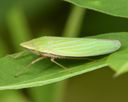Draeculacephala
Draeculacephala
Classification
- Phylum: Arthropoda
- Subphylum: Hexapoda
- Class: Insecta
- Order: Hemiptera
- Suborder: Auchenorrhyncha
- Infraorder: Cicadomorpha
- Superfamily: Membracoidea
- Family: Cicadellidae
- Subfamily: Cicadellinae
- Tribe: Cicadellini
- Genus: Draeculacephala
Pronunciation
How to pronounce Draeculacephala: //draɪˌkjuːləˈsɛfələ//
These audio files are automatically generated. While they are not always 100% accurate, they are a good starting point.
Images






Summary
Draeculacephala is a genus of leafhoppers, notable for being one of the most common and widespread genera in the New World, with at least 25 described species.
Physical Characteristics
Most species are green or straw-colored; generally 6 to 11 mm in length, with a triangular head projecting forward to a point.
Identification Tips
Many species cannot be differentiated based on male genitalia alone.
Habitat
Draeculacephala species can be found in various habitats including grasslands, lawns, fields, and some rare species in moist environments such as salt marshes and bogs.
Distribution
Throughout the New World; most diverse in the southern United States and Neotropics, but present throughout Canada.
Diet
Hosts primarily include grasses and sedges; most species are polyphagous, while those in moist habitats tend to be specialists.
Economic Impact
Can damage forage crops.
Tags
- Hemiptera
- Leafhoppers
- Cicadellidae
- Draeculacephala